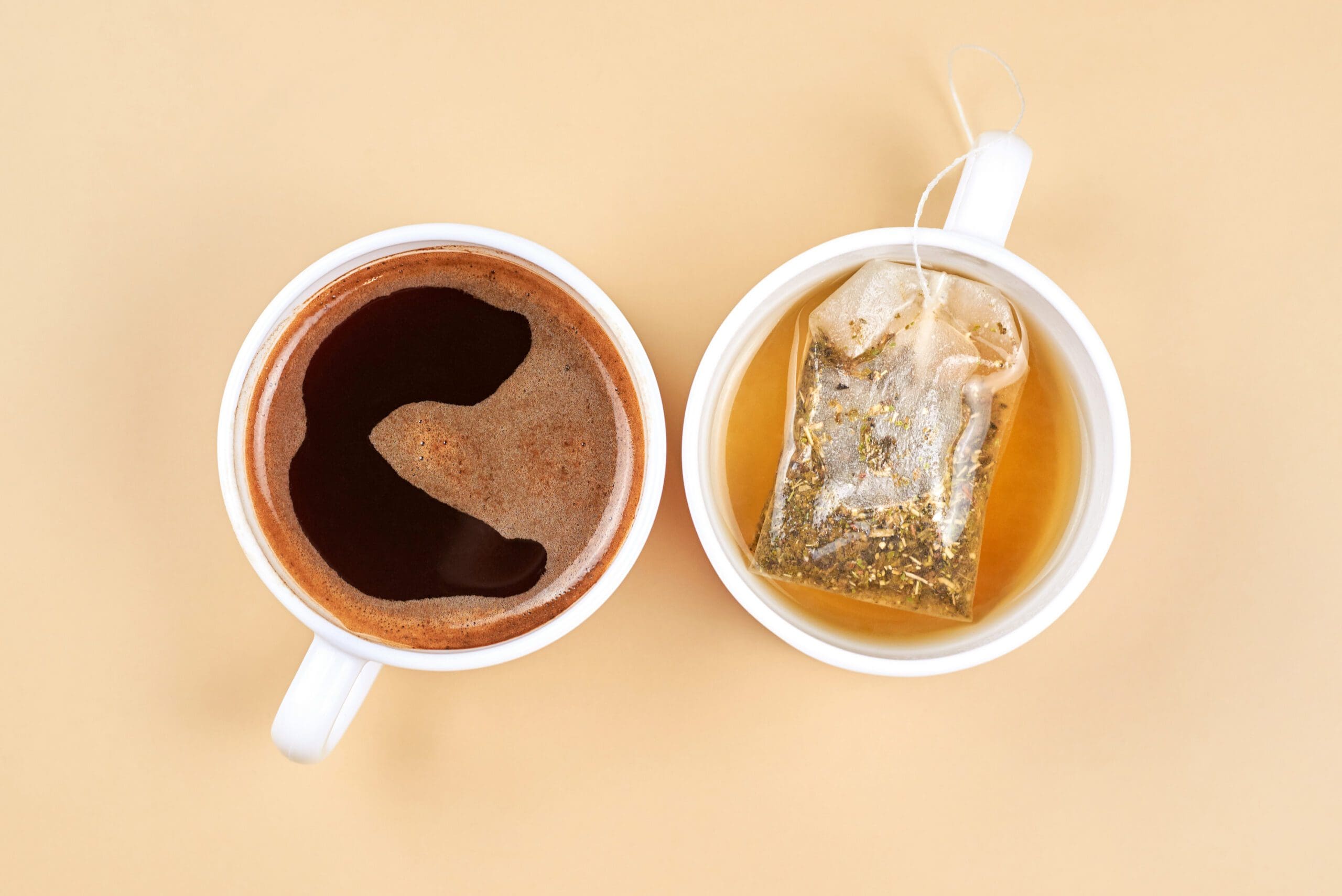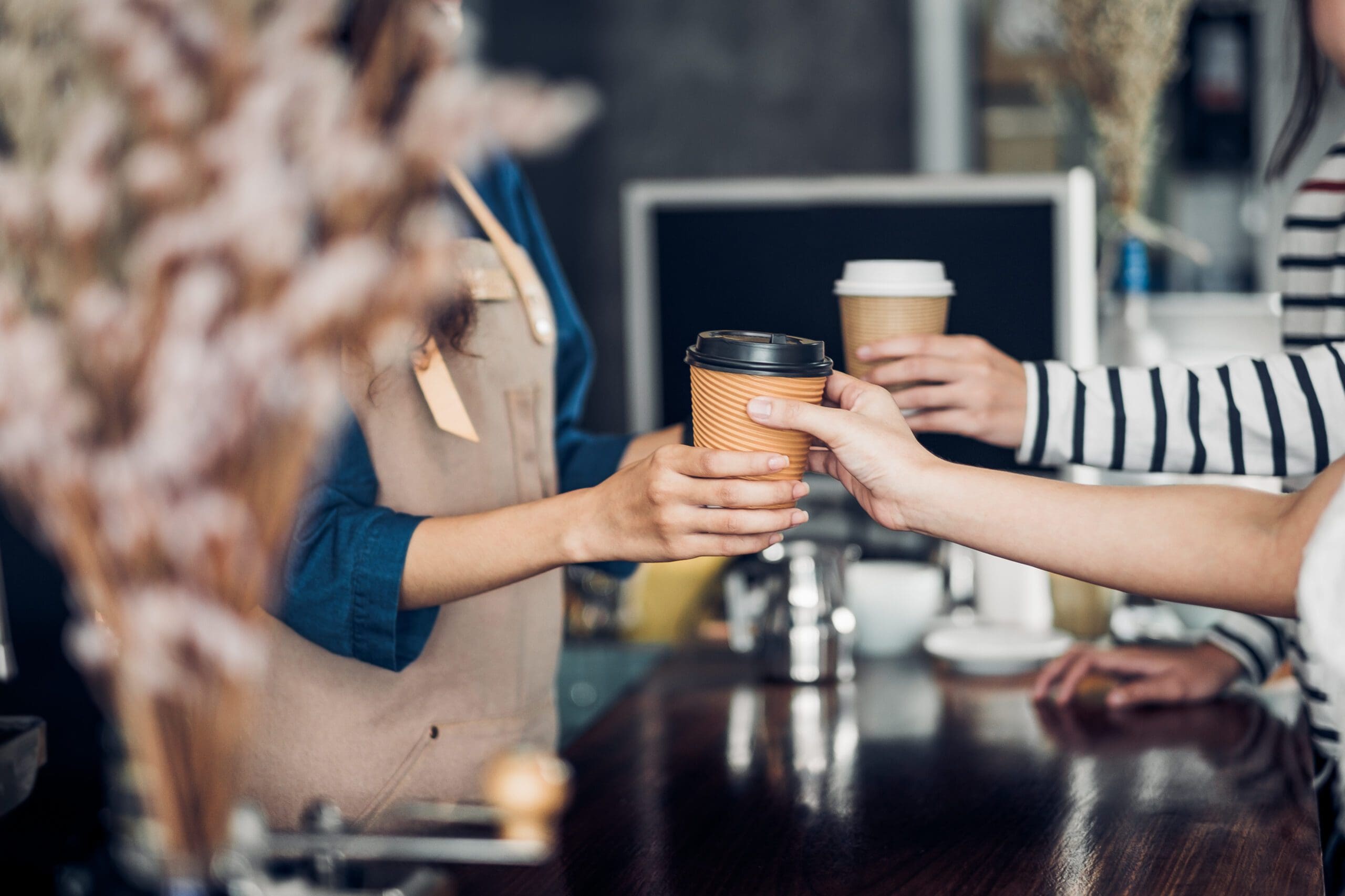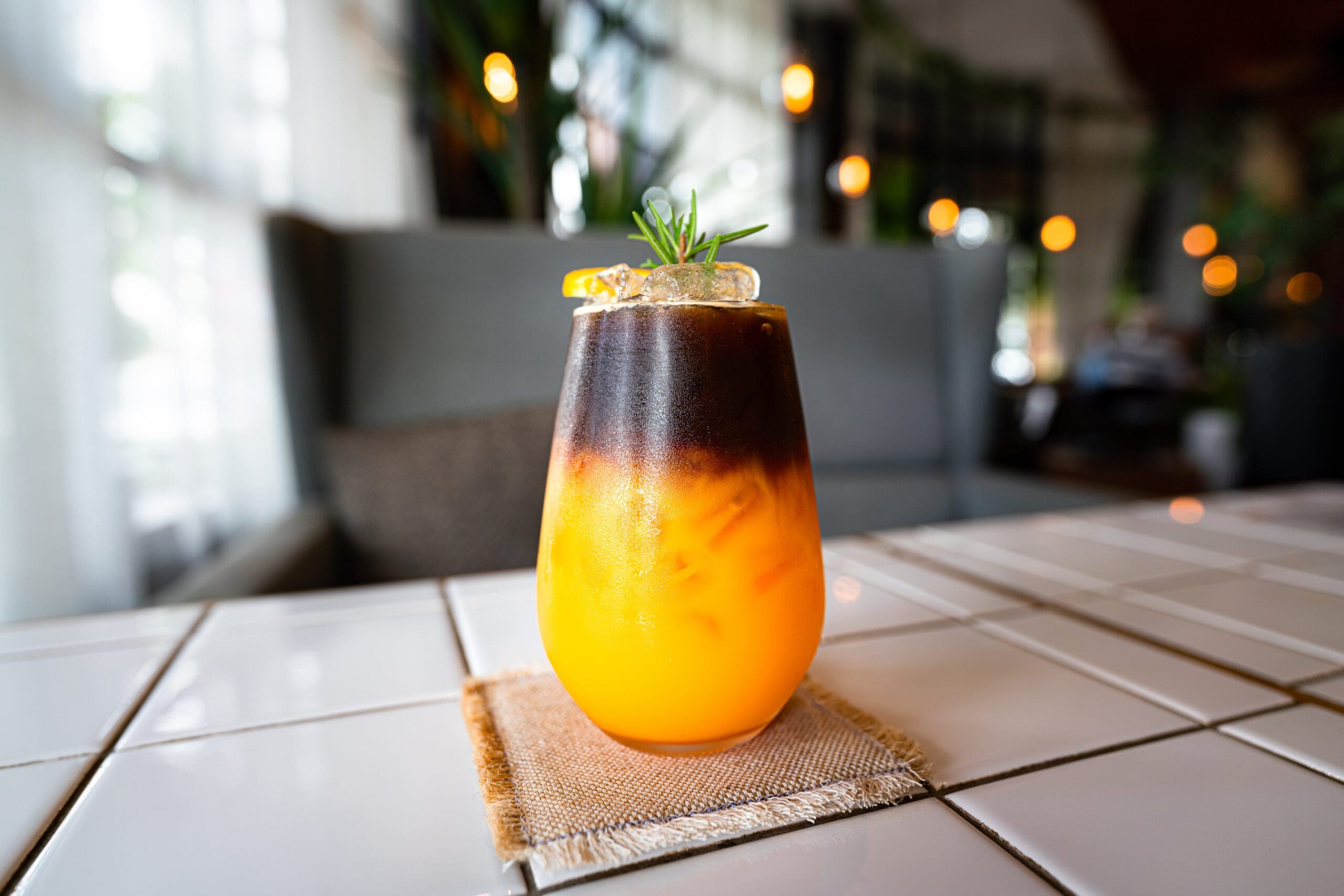How to Create Delicious No-ABV Cocktails from Coffee
and Citrus Juices
Coffee and orange juice have long lived side by side at the breakfast table. Recently, their relationship has started to change and given birth to a range of refreshing beverages that are too good to be limited to breakfast. Enjoy them in the afternoon, when you need a refreshing caffeine kick, or in the evening, when you crave a cocktail free of alcohol.
According to the TODAY SHOW, the no-ABV (no alcohol by volume) or “mocktail” segment is expected to reach $1.6 trillion (that is one-point-six-trillion dollars) by 2026. Dry January lasts 31 days, but you can find some favorite non-alcoholic, or “mocktail”, recipes that are delicious and nutritious all year round and for different occasions.
Before we share some of our favorite recipes, we’ll take a quick look at the history of each beverage in the US. If you can’t wait to start preparing and mixing, jump right down to the recipes.
COFFEE OVER TEA

According to the National Coffee Association, coffee was brought to the US in the mid-1600s. The first coffee houses appeared in New York, at that time New Amsterdam, but tea continued to be the colonists’ favorite beverage for another 100 years.
Americans’ preferences started to change in 1773 with the Boston Tea Party, the revolt against a high tax on tea imposed by King George III. Frustrated and angry, American colonists raided British tea ships and threw the crates of tea into the Boston harbor. After that, switching from tea to coffee became an act of patriotism.
In a story on NPR’s Morning Edition, historian Mark Pendergrast, author of “Uncommon Grounds: The History of Coffee and How It Transformed Our World”, confirms that there is a lot of truth to that story. The NPR segment mentions a letter John Adams wrote to his wife, Abigail, in which the Founding Father calls drinking tea unpatriotic. For that reason, Adams himself was prepared to embrace coffee, even though he actually preferred tea.
The Boston Tea Party was a turning point for coffee consumption in the US.
COFFEE ON THE GO

Today, 250 years later, two thirds of Americans drink coffee every day. According to the nca’s Coffee Data Trends (Fall 2022), consumption in the US amounts to an estimated 491 million cups of coffee a day. Coffee is the most popular beverage. It ranks even higher than bottled water.
Breakfast is the most important time for coffee. While coffee beverages are increasingly consumed throughout the day, the majority of coffee drinkers enjoy a cup in the morning, either at home or on the go.
By the way, according to an article by Pat Pape in NACS Magazine (National Association of Convenience Stores), the first place to offer coffee-to-go was a Long Island 7-Eleven store in 1964. Since then, consuming coffee on the go has become the norm for many Americans.
Coffee is no longer just a simple product. While regular drip coffee is still on the menu in many cafés, most venues offer a wide range of specialty coffees and coffee beverages. Consumers today expect freshly prepared espressos, cappuccinos, lattes, macchiatos, mochas, and more. Freshly brewed is key, as it provides enhanced taste. What’s more, it lets customers see, hear, and smell how their beverage is prepared for them, creating a full sensory experience.
CITRUS: THE BEGINNINGS IN THE US

Orange Juice has a much shorter history in the US. According to the Florida Department of Citrus, the first orange trees were planted in Florida in the 1500s. That was, however, still a long way from commercial growing. Grapefruit arrived in the US much later still, in 1823, as described in the article “Grapefruit: History, Use, and Breading”.
Commercial production of oranges and grapefruit in Florida did not begin until the second half of the 19th century.
In California, as described in the article “Citrus Production in California”, citrus fruits were introduced around 1769. Commercial citrus growing started about 70 years later, in 1841 in the Los Angeles area.
ORANGES: FROM EATING TO DRINKING
In the first decades of commercial production, oranges were grown primarily to be eaten as fruit. The main type in California was Navel, which was great for eating. The main types grown in Florida were Valencia and Hamlin, which would turn out to be ideal for juicing.
Nevertheless, orange juice didn’t appear on the scene until the early 20th century. By that time, orange production was running in overdrive, resulting in an oversupply of fruit. Juicing fruit was a logical solution.
Early ad campaigns encouraged consumers to not just eat oranges but squeeze them to make juice. So, at the beginning, orange juice was hand-squeezed and enjoyed fresh.
FROZEN CONCENTRATE: A RESULT OF WWII
What happened then is well documented. In the early 1930s, canned juice hit the market. However, it could not compete with the taste of freshly squeezed. Once canned, orange juice did not maintain its positive qualities well. It deteriorated quickly and lost its color and flavor.
It wasn’t until the early 1940s that the problem was solved, as described by Emelyn Rude in her 2017 Time article on the link between WWII and frozen orange juice:
Desperate to keep its troops well fed with Vitamin C, in 1942 the U.S. Army quartermaster offered a lucrative contract to whomever could figure out how to produce decent-tasting frozen orange juice. There would be no success until 1945, when a group of USDA scientists working in Florida developed a process to evaporate the liquid from fresh juice at relatively low temperatures. The result was a concentrated mass of orange. To this they added just a dash of fresh juice, which returned some of the essential oils and helped the drink to retain its citrusy flavor even in transit. Their efforts were promptly patented and subsequently released freely to the public.
Frozen concentrated orange juice (FCOJ) soon became widely available on the market. It was heavily supported by advertising, most famously by commercials featuring famous singer Bing Crosby. The ads worked their magic and FCOJ became the predominant form of juice.
FRESH IS BACK

After many years of inferior frozen product from concentrate, followed by heavily processed juices misleadingly marketed as “fresh”, truly freshly squeezed is back at many grocery stores and foodservice locations. In some places, you can even watch how the juice is squeezed right in front of your eyes on automatic juicing equipment.
Freshly squeezed juice is the closest you can get to eating the actual fruit.
- It’s vastly superior in taste.
- It contains nothing artificial.
- There’s no added sugar.
- It smells like fresh fruit.
- It’s got the color of fruit – and just like with fresh fruit, it is not uniform. Uniformity is only achieved through heavy processing.
The only disadvantage of freshly squeezed juice? It doesn’t have a shelf life of several weeks or months, like processed and packaged “fresh” juice. But who wants fresh that is several months old?
THE EVOLVING RELATIONSHIP

So now that we’ve had a brief look at the history of both coffee and orange juice, let’s turn to what is happening today in their relationship.
According to NACS, consumers are looking to ‘health-ify’ whatever they can, and coffee is no exception. This is in addition to increased awareness and demand for sustainability, plant-based products, and exotic flavors.
Over the past few years, more and more recipes have started popping up that combine coffee and orange juice in one single beverage. The combination might strike you as strange. We tried some of them and found that it works really well!
The recipes below are easy to make at home. All you need is some fresh fruit, a manual citrus press, and a coffee maker of your choice to brew either espresso, regular coffee, or cold brew.
If you run or own a commercial facility, such as a café or bar, you are probably using high-quality commercial brewing equipment. You may think about adding automated juicing equipment – especially, if you see that you need larger amounts of juice.
Below you will find 2 recipes for coffee and orange juice. Then we’ll move on to grapefruit. And finally, probably the most surprising combination: coffee and lime.
Now, to be clear: these combinations may not replace your morning latte or cappuccino, and we don’t believe that that’s their main purpose. We see them as exciting new non-alcoholic cocktails to be enjoyed on a hot afternoon or a dry evening out with friends: No ABV, but healthy, refreshing, and delicious.
A non-alcoholic beverage may or may not contain small amounts of alcohol, depending on the country or state you are ordering in. For example, in the USA, a non-alcoholic malt beverage may actually contain alcohol less than 0.5% by volume. A No-ABV beverage is understood to contain 0% alcohol, however, depending on who you ask, it may contain small amounts of alcohol. Ask to be sure. The recipes in this post do not contain any alcohol.
DELICIOUS NO-ABV DRINKS WITH COFFEE AND CITRUS
The amounts given are for two servings.
ORANGE ESPRESSO

The most basic combination is
- Espresso or other strong coffee
- Freshly squeezed orange juice
- Ice
Use a 1-to-1 ratio. So, if you have 8 oz of coffee, use about 1 cup of orange juice (4-5 oranges, depending on the type) and have 2 tall glasses ready.
- Start by preparing the espresso and let it cool just for a few minutes.
- In the meantime, squeeze your oranges.
- Fill each glass to the half with ice cubes.
- Pour the orange juice over the ice.
- Slowly add the espresso. If you pour it slowly, you’ll get a nice separation between the juice and the coffee, which looks beautiful for serving.
- Before you drink it, give it a quick stir to combine. Enjoy!
SPRITZY AMERICANO
Already a few years ago, Bon Appétit, wrote about this beverage on their website. The added seltzer makes this beverage a perfect thirst-quencher.
You’ll need:
- Espresso or other strong coffee
- Freshly squeezed orange juice
- Seltzer (we recommend unflavored)
- Ice
Use a 1-1-2 ratio. So, if you have 4 oz of coffee, use about 1/2 cup of orange juice (2-3 oranges), and 1 cup of seltzer.
- Start by preparing the espresso and let it cool for just a few minutes.
- In the meantime, squeeze your oranges.
- Fill two glasses to the half with ice cubes.
- Pour the orange juice over the ice.
- Add the espresso. No need to worry about pouring it slowly.
- Add the seltzer.
- Stir it and enjoy!
GRAPEFRUIT COFFEE
You might think that grapefruit and coffee together would yield a beverage too bitter to drink. But if you follow this recipe, you will be surprised at how smooth it is!
You’ll need
- Espresso or other strong coffee
- Honey
- Freshly squeezed grapefruit juice (we used two pink grapefruit)
- Ice
We used a 1-to-1 ratio of coffee and grapefruit juice.
- Start by preparing a strong espresso. We used 4 oz for 2 servings.
- Add 2 teaspoon of honey to the hot espresso and mix it until it is well combined. Set aside.
- Squeeze the pink grapefruit. We used about 1 cup of grapefruit juice.
- Fill two glasses to the half with ice.
- Pour the honey-sweetened espresso over it.
- Add the grapefruit juice.
- Give it a quick stir and enjoy it!
LIME COFFEE
This last recipe takes a bit more time, as you need to prepare a lime syrup. But it’s still easy and the effort is definitely worth it!
You’ll need:
- Freshly squeezed lime juice (from 2 limes) and zest (optional)
- Sugar
- Espresso or other strong coffee
- Tonic water (about 1 cup)
- Ice
- Start by preparing the Espresso. We used 4 oz of espresso. Let it cool for just a few minutes.
- Juice two limes.
- If you’re using organic limes, grate a bit of zest.
- In a small microwave-safe container, combine 1 tablespoon of water, 1 tablespoon of sugar, the juice from the two limes and the optional lime zest. Microwave until the sugar dissolves and you have lime syrup. Set it aside so it can cool a bit.
- Fill two tall glasses with ice.
- Add the lime syrup.
- Add about half a cup of tonic water to each glass.
- Add the espresso.
- Stir and enjoy!
A FEW MORE NOTES ON THE RECIPES
Be creative and inspired!
The above recipes are basic versions. You can easily spruce them up with herbs and garnishes. Be creative! You can also play around with the ratios and adapt them to your liking. Use the recipes as an inspiration to create your favorite citrus coffee drink!
What about milk or creamer?
You may be used to taking your coffee with milk or creamer and can’t imagine enjoying it without it. People add milk because it enhances the texture of coffee and masks some of the bitterness. Well, that’s where the orange juice comes in. You’ll find that you won’t need any milk or creamer. That said, we have tried it – and we would not recommend it. Orange juice and milk don’t combine well. The beverage will curdle and not look appealing.
What about store bought packaged juices?
You can make all recipes with packaged and processed juice and instant coffee. We at Citrus America love and prefer freshly squeezed, because only freshly squeezed has the perfect flavor profile and can add fresh and natural vitamins and nutrients to your beverage. We’d highly recommend using fresh coffee, or espresso, and freshly squeezed juice.
CLICK HERE TO FIND OUT WHY FRESHLY SQUEEZED ORANGE JUICE TASTES TO GOOD
CHANGING CONSUMER PREFERENCES
For almost a century, orange juice has been consumed at breakfast – along with coffee, before or after the first cup of coffee, or instead of it. The blend of the two into one beverage is a refreshing development.
It may have to do with changing consumer preferences, as described by NACS, and a shift from hot to cold. Cold-brew coffee is the fastest growing coffee drink. Older consumers tend to prefer regular hot coffee. Many still use traditional drip machines. Younger consumers, however, tend towards cold coffee and frozen coffee beverages.
In addition, younger consumers are open to innovation and like customization. Gen Z has grown up with the ability to customize many aspects of their lives, especially the food and beverages they consume. They like to customize cold coffee by adding different flavors or syrups. So why not add orange juice! Younger people are also more likely to consume a cold coffee beverage at lunchtime or later in the day. The coffee and orange, grapefruit, or lime combinations are ideal for that.
And finally, more and more consumers are looking for non-alcoholic beverages, whether it’s in bars or for home entertainment. The above recipes, especially when spruced up with the right herbs and garnishes, can be great alternatives to alcoholic cocktails.
HOW CITRUS AMERICA CAN HELP
If you have a bar, restaurant, café, or grocery store and would like to add in some amazing new non-alcoholic beverage options to your product offerings, Citrus America can help you develop the right citrus juicing strategies to support Healthy Profits.
Making a few citrus beverages at home with a manual juicer, citrus press, or hand reamer is relatively easy. However, for commercial establishments making many drinks per day, it usually makes sense for many reasons to invest in a high-quality commercial citrus juicer.
About Citrus America – Citrus America has been driving innovation and quality in the juicing segment for more than a decade in North America and the Caribbean. We’re the exclusive master distributor for Citrocasa and have driven many innovations and quality improvements in juicing equipment. In addition to equipment solutions, we provide tailored training and support strategies to help our customers earn Healthy Profits.
About Citrocasa – Citrocasa has been the pioneer in producing the most innovative and highest quality food grade stainless steel commercial citrus juicing equipment to the grocery, hotel, and restaurant since 2005 across Europe. The Citrocasa 8000 Series was launched in 2005, with the 8000XB and the 8000SB. The 8000SB-ATS was launched in 2013. The Citrocasa Fantastic Series was launched in 2010 with the Fantastic M/AS. The Fantastic F/SB followed in 2011. Between 2015 and today, Citrocasa has launched the Advance upgrades, The Revolution, The Eco, and has added new options for on-line connectivity continuing its role as being the leader in commercial citrus juicing quality and innovation.







